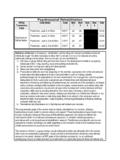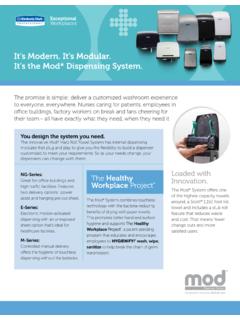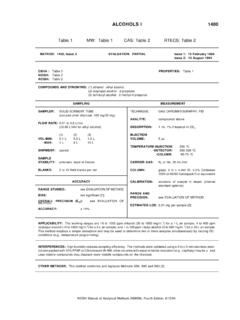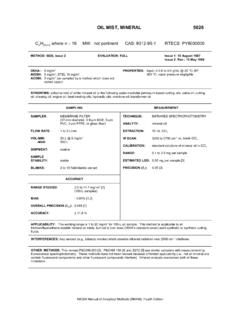Transcription of INSTALLATION OF WOODWORK - MOD Interiors
1 524 Modular CabinetsSection 16001600 2003 AWI/AWMAC - 8th Edition Quality Standards INSTALLATION OF WOODWORKSECTION1700 INSTALLATION of WoodworkSection 17005261700 2003 AWI/AWMAC - 8th Edition Quality Standards 527 INSTALLATION of WoodworkSection 17001700 2003 AWI/AWMAC - 8th Edition Quality Standards General Criteria1700-G-1 ScopeThis section defines the Standards for the INSTALLATION of architec-tural WOODWORK , casework, and related WOODWORK : INSTALLATION shall be by the WOODWORK fabricator or a company specializing in the INSTALLATION of architectural WOODWORK and casework or the general firm accepting responsibility for the INSTALLATION shall employ experienced craftspersons who can complete the work per the Grade specified and defined by this installer shall check all architectural WOODWORK and/or casework supplied as compliant with applicable sections of this standard, or as modified by the contract documents, for the Grade specified.
2 The installer shall also be familiar with the WOODWORK shop drawings and their relationship to the completed Grade INSTALLATION shall be by inconspicuous : The INSTALLATION of architectural WOODWORK . (The fabri-cation and finishing of the WOODWORK is covered in previous sections.) INSTALLATION of WOODWORK under this Standard shall include labor, tools, equipment, adhesives, fasteners, common ex-ternal blocking, furring and hanging devices for the support or attachment of the installer shall be responsible for: Receiving and distributing WOODWORK to the proper lo-cation.; INSTALLATION of finish hardware not furnished by the man-ufacturer; INSTALLATION of adjustable shelves, standards and brackets on building walls, and shelf clips or pins in cabinets, cabinet standards and/or in-line boring done by manufacturer; On prefinished WOODWORK , all the filling of nail holes and touch up on the prefinished WOODWORK after INSTALLATION to achieve best color blend; Preparation of walls for paneling included in contract, including INSTALLATION of 19 mm x 64 mm [3/4 x 2-1/2"] min-imum veneer core plywood or solid wood grounds, and/or extruded aluminum strips and clips; set plumb and true, squaring out corners, windows and door openings up to and including mm [1/2"].
3 Excludes:Unless required by the specifications and/or a specific requirement of this section of the Standards to follow, the installer shall not: Provide structural grounds or blocking inside partitions or above finished ceiling or below finished floor; Supply exposed materials other than wood, solid surfacing, or plastic laminate; Factory or site-applied finish to unfinished or primed WOODWORK ; Fill nail or screw holes in unfinished or primed wood-work; Caulk to fill between WOODWORK and any wall, floor, and/or ceiling imperfections; Prepare wall, floor, or ceiling to accept the WOODWORK ; Install electrical, telephone, plumbing, computer, or mechanical equipment to include grommets and wire man-agement; Supply electrical power, water, hoisting, sanitary or waste disposal services; Supply fastening devices unrelated to the architectural WOODWORK being installed; Provide buildups to level floor or walls in excess of mm [1/2"] at any one point; or Seal edges, tops and/or bottoms of wood RequirementsGRADE MUST BE SPECIFIEDT hese Quality Standards Illustrated provide for three Grades: Premium, Custom, and GradeThe Grade specified when the highest degree of control over the quality of workmanship, materials, INSTALLATION and execution of the design intent is required.
4 Usually reserved for special projects, or feature areas within a GradeThe Grade specified for most conventional architectural wood-work. This Grade provides a well-defined degree of control over the quality of workmanship, materials and INSTALLATION of a project. The vast majority of all work produced is Custom GradeThe Grade which defines the minimum expectation of quality, workmanship, materials, and INSTALLATION within the scope of these Section 1700 INSTALLATION of WoodworkSection 17005261700 2003 AWI/AWMAC - 8th Edition Quality Standards 527 INSTALLATION of WoodworkSection 17001700 2003 AWI/AWMAC - 8th Edition Quality Standards Prevailing GradeWhen the Quality Standards Illustrated are referenced as a part of the contract documents and no Grade is specified, Custom Grade standards shall prevail. In the absence of specifications or requirements of this Standard, materials shall be unfinished mill option lumber or veneers suitable for opaque finish, with mill option hardware, fasteners, adhesives, overlays, and specialty and specifications shall define:A.
5 The QSI Grade of Work required;B. The method of anchoring all architectural WOODWORK items, including trim, paneling, cabinets, plastic and labo-ratory tops, and specialty items;C. The type, size, frequency, and/or spacing of anchoring devices and fasteners;D. The clearance at bottom of wood doors to accommodate floor coverings; andE. Whether priming or backpriming is required and, if so, by Conditions, Materials, and PreparationIt is the responsibility of the general contractor to insure the following site conditions which are required for the INSTALLATION to meet these Quality Standards Walls, ceilings, floors, and openings must be level, plumb, straight, in-line, and square. Note: In the absence of floor tolerances in the contract documents, variance of a cabinet s toe base height due to floor variations is not a defect. Casework is required to be installed level. Shimming of toe base, not to exceed mm [1/2"], is acceptable. Floor variations exceeding mm [1/2"] shall be corrected before cabinets are installed.
6 Wall panel installations are subject to the same tolerances at wall or ceiling. Correction is not the responsibility of the manufacturer or Prior to delivery and INSTALLATION of architectural wood-work, casework and related WOODWORK , to the job site, the building environment shall be stabilized to provide condition that will maintain a relative humidity of not less than 25%, nor more than 55%. Note: These parameters apply for most of North Amer-ica. See the data at the end of this section on relative humidity and moisture content for specific guidelines. In any event, rela-tive humidity during the time of INSTALLATION shall remain within the range to be maintained during occupancy. All woods are affected by humidity, which is the water/moisture, in vapor form, in the atmosphere, but not appreciably by heat. Lumber swells and shrinks, primarily in two directions only, thickness and width, and insignificantly in length. These changes in dimension, due to effects of humidity, vary with different spe-cies.
7 Providing and maintaining a stable environment, from the time of delivery, through INSTALLATION , and on through building occupancy, is the key to minimizing the effects of Areas to receive architectural WOODWORK must be fully enclosed with windows installed and glazed, exterior doors in place, HVAC systems operational, and temporary open-ings closed. All plaster, wet grinding, and concrete work shall be fully A secure storage area must be provided within the building that is flat and level, clean, dry, well ventilated, protected from direct sunlight, and broom Unless specified as part of the installer s contract, it is the responsibility of the general contractor to furnish and install structure, grounds, and blocking, or other anchorage which become part of the walls, floors, or ceilings, required for architectural WOODWORK All metal backing strips welded to steel studs shall be as specified and/or detailed on architectural/design drawings to show locations and gauge of thickness of these Should the architect, designer, or engineer omit details calling for the general contractor to supply necessary block-ing or backing strips in the wall, either through inadvertence or otherwise.
8 The architectural WOODWORK installer shall not proceed with the INSTALLATION until such time as the block-ing is installed by others. The owner or owner s general contractor is responsible for placing blocking acceptable to the WOODWORK installer prior to INSTALLATION with no penalty to the WOODWORK manufacturer or All preparatory work done by others shall be subject to inspection by the architectural WOODWORK installer, and may be accepted or rejected prior to commencing Rough openings which are installed by installed by others prior to commencement of INSTALLATION shall be built square, in plane, and to the proper WOODWORK is a finish trade, and should be in-stalled after ceilings, plumbing, flooring, etc. The fabricator of the work shall not be held responsible for any damage that might develop by others not adhering to the above and Storage RequirementArchitectural WOODWORK shall be delivered to the jobsite only after all painting, wet work, grinding, and similar operations are completed.
9 For most areas of North America, the ambient relative humidity at the site, including both the storage and the INSTALLATION areas, should be maintained between 25% and 55% prior to delivery and through the life of the INSTALLATION . In any event, the range of relative humidity change should not exceed 30 percentage points. Relative humidity below 20% and above 80% is particularly harmful to wood and wood products, not to mention fabrics, ceiling materials, and flooring, wall coverings and the human of WoodworkSection 17005281700 2003 AWI/AWMAC - 8th Edition Quality Standards 529 INSTALLATION of WoodworkSection 17001700 2003 AWI/AWMAC - 8th Edition Quality Standards 1700-G-5 INSTALLATION (when specified)The methods and skill involved in the INSTALLATION of WOODWORK in large measure determine the final appearance of the project. Architectural WOODWORK shall be allowed to come to equilibrium on site prior to INSTALLATION . A minimum of 72 hours shall be allowed for best results.
10 Factory finished WOODWORK will require a week or more to acclimatize. The design, detailing and fabri-cation should be directed toward achieving INSTALLATION with a minimum of exposed face fastening. The use of interlocking wood cleats or metal hanging clips combined with accurate furring and shimming will accomplish this. Such hanging of WOODWORK has the additional advantage of permitting movement that results from humidity changes or building (when specified)This section does not cover finishing. However, site conditions for finishing are rarely conducive to good results. Poor lighting, dust-laden air, and available techniques are limiting factors. In many areas woodworkers will factory finish, yielding better results than can be achieved from field and back priming are the responsibility of the general contractor unless specified projects are factory finished under Section 1500, field touch-up is the responsibility of the installing contractor, and includes the filling and touch-up of exposed job-made nail or screw holes, refinishing of raw surfaces resulting from job fitting, repair of job-inflicted scratches and mars, and final cleaning of the finished surfaces.








